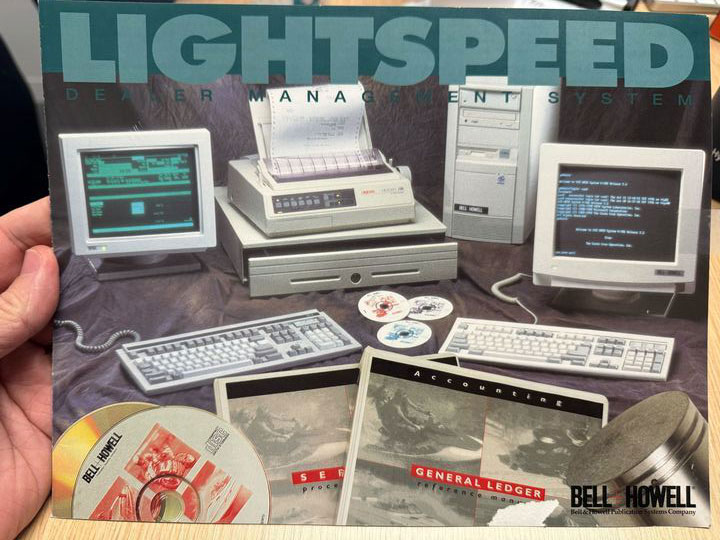Lightspeed has a long legacy of innovating and supporting dealers in the outdoor recreation industries. While so many have contributed to this legacy, we can trace some of Lightspeed’s earliest innovations and visions back to Hal Ethington, one of Lightspeed’s earliest and most influential contributors, who was a dealer himself.
He was also a visionary in how he saw the future of the industry, connected with dealers, and understood their needs and challenges. In this “Then and Now” series, we’re revisiting the most impactful articles that Hal wrote from the 2000s and pairing them with fresh insights from our Chief Sales Officer, Brian Bodine. To learn more about how Hal created Lightspeed, check out the introduction to this series here.
In this edition, Hal and Brian both address how your data can work seamlessly to help you run your business more effectively, and how the technology of Lightspeed can help.
From Hal:

“You might find that your computer is no longer providing you with good information and that you are, instead, spending a great deal of time providing the computer with information. At some point, the computer system stopped being a tool to help you run your business and became just one more of the many tasks that you have to contend with.
Even the best software program is only as good as the data that it receives. Over the years, your database has had a lot of information added to it: new customers, new part numbers, new units, and new work orders have all been diligently recorded. How much of that data is incomplete or totally useless but has never been removed or corrected?
Here are some signs that your computer system is now running you ragged instead of helping you run your business.
- Do you have part numbers in your system that were special-ordered for one customer one time and have never been ordered or sold since? These old, inactive numbers fill your inventory reports, cloud your suggested orders, and can add thousands of detracting lines to your physical inventory count sheets.
- Do you have old work orders in the system waiting now for months or even years for the customer to come in with the bike? These useless RO’s cloud the current picture and add confusion to the service manager’s job. That manager should be able to follow-up on current work orders in progress and move them along without wading through years of clutter.
- Does your service history show every single repair order that your shop has ever performed? There is a balance here. You want to make sure you can look up service history, but do you really need every single RO you have ever completed? Too much data in any system will at some point affect the performance of that system.

Take a hard, critical look at your database, and clean it up. Some will say they just don’t have the time to do this. But you must make the time because it will hurt you eventually and cost you time later on. To be profitable, you must have your finger on the pulse of the business. You will miss business opportunities or, worse, make costly mistakes if your information is not accurate or if it takes too long to gather and understand. The best way to escape from a problem is to solve it.”
Brian Bodine also has some updated insights on how Lightspeed helps dealers manage their data better than ever before:
“Right off the bat, one of the most underrated products that we have is Lightseed Industry Benchmarks. If you were to pay for somebody to analyze your dealership and compare it to not only regional averages but national averages, you would pay hundreds of thousands of dollars. We have these reports built right into Lightspeed. And so you can see where you’re at, benchmark it, set goals internally, and measure it all against the industry.

Ultimately, if you’re looking at old data or even have just old processes, you’re going to fall behind. You’re not being competitive. You have to be able to look at the most current real-time data to make accurate decisions. Cleaner data is going to allow you to make faster decisions because you’re not going to have to sort through it all to find the right information.
Here are a few more ways to put your data in a position for success:
- Create a consistent naming convention for your reports and a protocol for where to save them. I can’t tell you how many dealerships I’ve been to where they have thousands of reports but don’t know how to search or organize them.
- Go through old data and take stock in it. If you have old, dormant or incomplete customer records, update them or delete them. It’s also a great opportunity to review your customer base and check in with customers you haven’t connected with in a while.
- The same goes for inventory. With tools like Lightspeed’s Parts Locator, it’s easy to locate a part, but you still have to have good inventory management practices. Check inventory to see if there are specialized or one-off part orders that you don’t need and get rid of them.”
Even as years pass, the same lesson is true – your decisions are only as good as the information you have. And your decisions are the basis for a well-run organization. So it’s time to treat your data like exactly what it is, fuel for a successful business. Get it in the right place so your business can run smoothly all season long.
For more information on Lightspeed, contact your local sales representative. And stay tuned for more installments of our “Then and Now” series with valuable insights from Hal and Brian.


